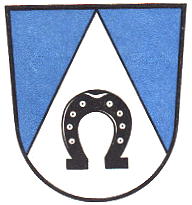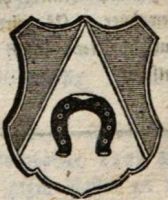Bobingen: Difference between revisions
Jump to navigation
Jump to search
Knorrepoes (talk | contribs) m (Text replacement - "|'''English''' ↵| {{blazon wanted}}" to "|'''English''' | blazon wanted") |
Knorrepoes (talk | contribs) No edit summary |
||
| Line 1: | Line 1: | ||
{| class="wikitable" | |||
|- style="vertical-align:top;" | |||
|[[File:bobingen.jpg|center|350 px|alt=Wappen von {{PAGENAME}}/Arms (crest) of {{PAGENAME}}]] | |||
| | |||
<center>''' {{uc:{{PAGENAME}}}} '''</center><br> | |||
'''Country''' : Germany [[File:germany.jpg|60 px|right]]<br><br><br><br> | |||
'''State''' : [[Bayern]][[File:Bayern.jpg|60 px|right]]<br><br><br><br> | |||
'''District (Kreis)''' : [[Augsburg (kreis)|Augsburg]] (until 1973 [[Schwabmünchen (kreis)|Schwabmünchen]])[[File:Augsburg.kreis.jpg|60 px|right]]<br><br><br><br> | |||
'''Additions''':<br> | |||
* 1972 [[Reinhartshausen]] | |||
* 1972 Straßberg | |||
* 1975 [[Kreuzanger]] (partly) | |||
* 1975 [[Waldberg]] | |||
{{#display_map:48.2682,10.8328|width=250|height=250|zoom=7}} | |||
|} | |||
{| class="wikitable" | {| class="wikitable" | ||
| Line 13: | Line 20: | ||
|- | |- | ||
|'''German''' | |'''German''' | ||
| | | In Blau eine silberne Spitze, darin ein schwarzes Hufeisen. | ||
In Blau eine silberne Spitze, darin ein schwarzes Hufeisen. | |||
|- | |- | ||
|'''English''' | |'''English''' | ||
| Line 25: | Line 31: | ||
The arms first appear on a seal from the early 19<sup>th</sup> century. The horseshoe is probably the village symbol. In 1768 Clemens Wenezclaus, Bishop of Augsburg summoned all villages to use a specific village sign for border stones etc. Why a horseshoe was chosen is not known. In 1837 the Bavarian colours were added to the horseshoe. | The arms first appear on a seal from the early 19<sup>th</sup> century. The horseshoe is probably the village symbol. In 1768 Clemens Wenezclaus, Bishop of Augsburg summoned all villages to use a specific village sign for border stones etc. Why a horseshoe was chosen is not known. In 1837 the Bavarian colours were added to the horseshoe. | ||
<gallery widths=250px heights=200px perrow=0> | |||
File:Bobingen1841.jpg|alt=Wappen von Bobingen/Arms (crest) of Bobingen|The arms in Kramer (1841) | |||
| | File:Bobingenp.jpg|alt=Wappen von Bobingen/Arms (crest) of Bobingen|Postal cancellation (with [[Aniche]]) | ||
</gallery> | |||
[[Civic Heraldry Literature - Germany|'''Literature''']]: Stadler, 1964-1971, 8 volumes. | [[Civic Heraldry Literature - Germany|'''Literature''']]: Stadler, 1964-1971, 8 volumes. | ||
{{de1}} | {{de1}} | ||
Revision as of 08:30, 20 July 2023
|
Country : Germany State : Bayern District (Kreis) : Augsburg (until 1973 Schwabmünchen) Additions:
|
| German | In Blau eine silberne Spitze, darin ein schwarzes Hufeisen. |
| English | blazon wanted |
Origin/meaning
The arms were officially granted on September 29, 1837.
The arms first appear on a seal from the early 19th century. The horseshoe is probably the village symbol. In 1768 Clemens Wenezclaus, Bishop of Augsburg summoned all villages to use a specific village sign for border stones etc. Why a horseshoe was chosen is not known. In 1837 the Bavarian colours were added to the horseshoe.
Postal cancellation (with Aniche)
Literature: Stadler, 1964-1971, 8 volumes.




